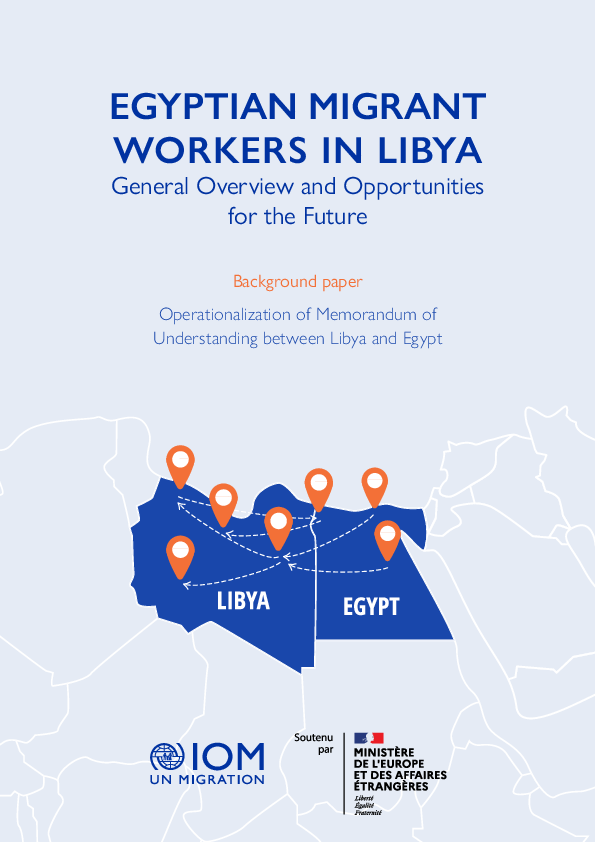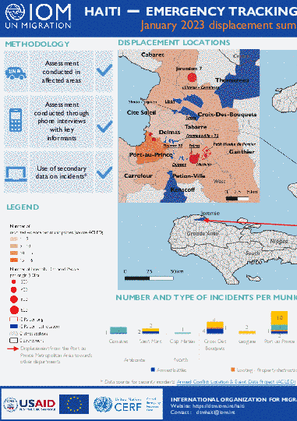-
Countries
-
Data and Analysis
-
Special Focus
-
Crisis Responses
Since the onset of the war in Ukraine, refugees from Ukraine and Third-Country Nationals1 (TCNs) have been fleeing into neighbouring countries in high numbers. According to UNHCR, over 17 million (17,408,643) border crossings from Ukraine have been registered by national authorities of six neighbouring countries between 24 February 2022 and 10 January 2023. Additionally, over the same period, 7.9 million refugees from Ukraine have been registered across Europe, in total. At the same time, more than 9 million (9,376,677) border crossings to Ukraine were registered from neighbouring countries.
This report focuses on TCNs’ border crossing movements in and out of Ukraine, as well as on their registered presence across European countries and on their profiles, needs and intentions.
Arrival and departure statistics are compiled from a variety of sources, mainly provided by national border authorities of countries neighbouring Ukraine to IOM. Registration and/or presence of TCNs from Ukraine across Europe is sourced from official statistics by national authorities and Eurostat. Data for Belarus does not allow for any trend analysis, data for Hungary was not provided to IOM after 25 April 2022. The information from national authorities is continuously verified and cross-checked to ensure consistency across countries and over time. Nevertheless, readers should be aware of the possible break in time series and that – as the war prolongs over an extended period – the same individual can cross the border from/to Ukraine multiple times for various reasons. Hence, total values for the entire period refer to border crossings rather than individuals.
The TCNs profile in terms of socio-demographic characteristics, main needs upon displacement and intentions is based on IOM’s Displacement Tracking Matrix (DTM) survey data collected in 2022 in 12 European countries.

Contact
DTM Libya, DTMLibya@iom.int
Language
English
Location
Libya
Snapshot Date
Feb 16 2023
Activity
- Other
This background paper on Egyptian Migrant Workers in Libya aims to provide an overview of the situation and opportunities for this population. It was drafted with the aim of guiding the operationalization of a Memorandum of Understanding (MoU) on labour migration signed by both states in 2021. The document was drafted by LMI unit, using DTM data sources, including IOM’s Flow Monitoring Survey (FMS) as well as qualitative interviews with Egyptian migrant workers collected in June 2022. The report provides significant insights into Egyptian migrant workers conditions, including their mode of entry in Libya; employment status; access to documentation; ability to send remittances and mobility intentions. The paper outlines that, while the signature of a MoU between Libya and Egypt is a significant step, its prompt operationalization and the creation of regular pathways between both countries is paramount to ensure the protection of Egyptian Migrant workers in Libya.

Contact
DTM Haiti, dtmhaiti@iom.int
Language
English
Location
Haiti
Period Covered
Jan 01 2023
Jan 31 2023
Activity
- Mobility Tracking
- Event Tracking
The objective of the Emergency Tracking Tool (ETT) is to collect information on large and sudden population movements as well as security and climactic emergencies. Information is collected through phone interviews with key informants (at least 3) and direct observation. This dashboard presents information on important population displacement that occurred in January 2023. In total, 361 households (1,888 persons) were displaced during this month due to armed attacks.

Contact
DTMUkraine@iom.int
Language
English
Location
Ukraine
Period Covered
Jan 16 2023
Jan 23 2023
Activity
- Survey
To support partners in providing targeted, evidence-based assistance to the most vulnerable among those who have returned to their areas of habitual residence following a period of forced displacement, DTM Ukraine presents the third Ukraine Returns report. This January 2023 edition includes a detailed analysis of data collected through the twelfth round of IOM’s General Population Survey, conducted between 16 and 23 January 2023 among the adult population in Ukraine
This edition of the Ukraine Returns Report includes data and an analysis of the profile and intentions of those displaced abroad provided by the IOM Regional Office in Vienna. It also provides preliminary findings from the first round of IOM’s Conditions of Return Assessment (CoRA), a multi-sectoral location assessment deployed across key oblasts of return conducted in January and February 2023. In addition to the core survey modules, Round 12 offers detailed data on the household income of the returnee population, the envisaged usage of financial assistance and average monthly expenditure on utilities and other heating costs.
For the purposes of this report, the terms "return” and "returnee” are used without prejudice to status and refer to all persons de-facto in their place of habitual residence after a significant period of displacement (minimum of two weeks since February 2022), regardless of whether they returned to these locations spontaneously from abroad or from displacement within Ukraine. This definition excludes those who have come back to Ukraine from abroad but who have not returned to their places of habitual residence in country.
This Returns report in Ukrainian may be accessed here.

Contact
DTM CAR, DTMRCA@iom.int
Language
English
Location
Central African Republic
Period Covered
Dec 01 2022
Jan 08 2023
Activity
- Mobility Tracking
- Baseline Assessment
Ce rapport fournit un aperçu des déplacements et des besoins humanitaires multisectoriels dans les localités d’accueil des personnes déplacées internes (PDI) et / ou retournées. Les résultats ont été obtenus après la conduite du dix-septième cycle de suivi des déplacements (round 17) réalisé entre le 01er décembre 2022 et le 08 janvier 2023 par l’Organisation Internationale pour les Migrations (OIM) grâce au soutien du Bureau pour l’Assistance Humanitaire (en anglais, Bureau for Humanitarian Assistance, BHA), la Direction Générale de la Protection Civile et des Opérations d’Aide Humanitaire Européennes (DG ECHO) et le Fonds Humanitaire (FH). L’évaluation a couvert 4 0711 localités d’accueil des PDI et / ou retournés et 81 sites de déplacement identifiés préalablement avec les autorités locales en plus de 16 préfectures du pays et de la ville de Bangui.

Contact
DTM Sudan; dtmsudan@iom.int
Language
English
Location
Sudan
Snapshot Date
Feb 15 2023
Activity
- Mobility Tracking
- Event Tracking
The DTM Emergency Event Tracking (EET) is deployed to track sudden displacement and population movements, provide more frequent updates on the scale of displacement, and quantify the affected population when needed. As a subcomponent of the new Mobility Tracking methodology in Sudan (Round Five), and activated on a need basis, EET utilises a broad network of key informants to capture best estimates of the affected population presence per location – a useful tool for humanitarian response planning and design.
This report is coming as part of collaboration between IOM and FAO on a joint study to identify the needs of the displaced population and strategies for restarting agricultural production in conflict-affected rural areas in an effort to assist the Iraqi Government in addressing the challenges currently faced by the displaced farming population in their return to farming.
The study aims to:
1. Identify the role that agriculture plays as a source of livelihood for internally displaced persons (IDPs) and returnees.
2. Understand the drivers, constraints and challenges confronted by displaced and returnee households regarding return to areas of origin and resumption of farming.
3. Investigate how best to rehabilitate the agricultural sector to create opportunities for resilient and robust agricultural livelihoods for returnees and prospective returnees.

Contact
DTM Somalia, IOMSomaliaDTM@iom.int
Language
English
Location
Somalia
Period Covered
Dec 01 2022
Dec 31 2022
Activity
- Flow Monitoring
A total of 30,220 movements were observed in December 2022, representing a 27% increase compared to 2021 when 27,779 movements were observed during the same period. If compared with December 2021, Buuhoodle (53%), Doolow (43%), Harirad (34%), Bossaso (18%) and Dhobley (15%) FMPs recorded an increase in movements while Lowyacado (-25%) and Cabudwaaq (-6%) FMPs recorded a decrease in movements. Doolow (26%), Buuhoodle (24%) and Cabudwaaq (21%) FMPs recorded the highest numbers of incoming flows, while Doolow (52%), Bossaso (32%) and Dhobley (7%) recorded the highest numbers of outgoing flows.
Some regions of West and Central Africa (WCA) are faced with several layers of vulnerability resulting, among others, from weak state presence and capacity, limited access to basic services, struggling economies, slow-onset and rapid impacts of climate change, exponential demographic growth, rising urbanization, and general insecurity due to the presence of communal conflicts and the expansion of Non-State Armed Groups (NSAGs). In this context, weak governance systems and growing insecurity leave local populations to compete for dwindling natural resources, thereby placing further strain on social cohesion and undermining peaceful coexistence within and between communities. This is especially the case with respect to transhumance.



